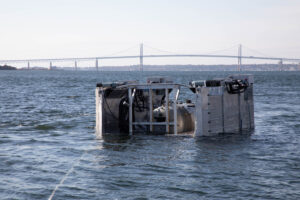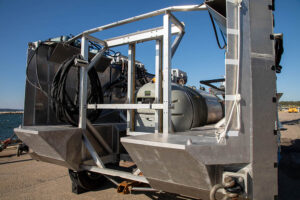A Navy team in October demonstrated a new launch and recovery concept for large unmanned undersea vehicles (UUVs) using an HII platform, the service said on Monday.
The demonstration entailed land-based launch and recovery approach and a new solution to launch large UUVs from Navy amphibious ships at the Naval Undersea Warfare Center (NUWC) Division Newport Narragansett Bay Test Facility. The testing used a Snakehead large displacement unmanned undersea vehicle (LDUUV) prototype and an HII [HII] Pharos large launch and recovery vehicle (LLRV).

Snakehead is an accelerated acquisition multi-mission LDUUV program that seeks to field modular long-endurance multi-mission vehicles that can be deployed from Littoral Combat Ships, attack submarines and ports. It was originally planned to be used to support intelligence, surveillance and reconnaissance and anti-submarine undersea missions.
This test followed a June demonstration when HII launched and recovered its internal Proteus large diameter UUV with the Pharos system while the Pharos was being towed behind a small craft to simulate an amphibious ship traveling at low speed (Defense Daily, June 14).
Following that event, HII entered into two Cooperative Research and Development Agreements (CRADA) with Naval Surface Warfare Center Panama City, Fla., division and NUWC Division Newport.
The company said it designed and built a surrogate system that was initially tested on land in Panama City to ensure it could accommodate the Snakehead phase one LDUUV in a loaded condition. HII argued that event “demonstrated that Pharos can be adapted to a wide range of vehicles, including LDUUVs.”
The October the Narragansett test was the next phase in the development program. HII said in this event the Pharos was embarked with the Snakehead in its cradle and both were lowered down and pulled up a ramp to simulate embarking in an amphibious ship’s well deck.
HII said this simulation made sure the 22,000-pound pull force was within the capabilities of an operational Navy Amphibious Transport Dock (LPD).

“These demonstrations validate a near term launch and recovery capability for the Pharos system. HII accelerates the transitioning of new technology into the customer’s mission, thus we are eager to enter the next phase of testing and demonstrate a launch and recovery from an LPD,” Todd Borkey, HII’s executive vice president and chief technology officer, said in a statement.
“This successful demonstration emphasizes that collaboration with the government and industry is key to build and test innovative solutions to increase the operational value that Large UUVs bring to the fleet,” Cheryl Mierzwa, Snakehead LDUUV technical project manager, added.
HII noted Pharos started as one of 40 mothership-based launch and recovery concepts from an independent corporate research and development project. Pharos was the down-selected finalist with the goal of demonstrating its capability of launching and recovering an LDUUV from an LPD.
HII’s Ingalls Shipbuilding, based in Pascagoula, Miss., designed, developed and constructed the Pharos concept for these kinds of demonstrations.